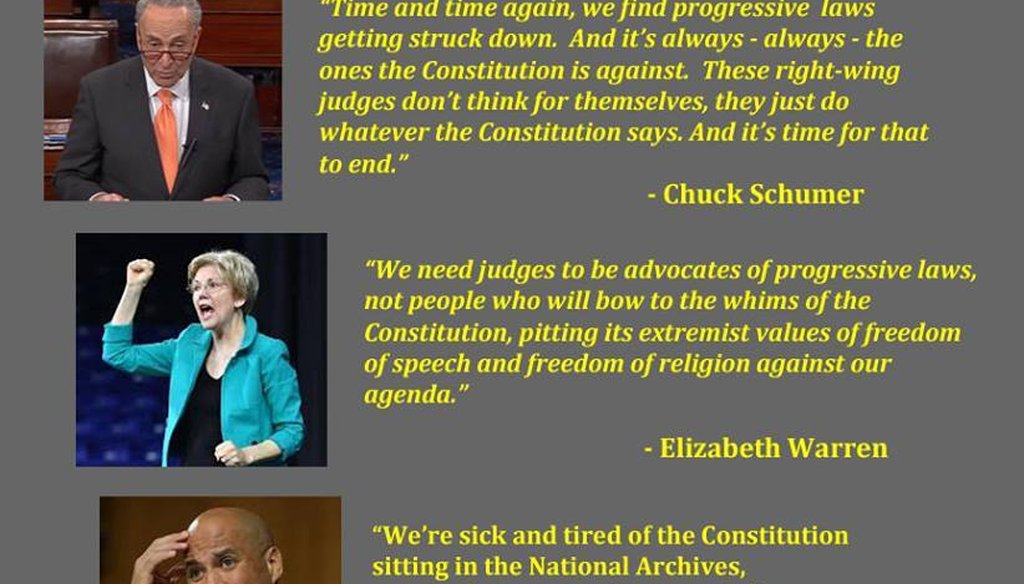Stand up for the facts!
Our only agenda is to publish the truth so you can be an informed participant in democracy.
We need your help.
I would like to contribute

This graphic breaking down the Iran nuclear deal, which originated in the office of Republican Sen. Mark Kirk, is circulating the Internet and was forwarded to us by a reader.
The nuclear deal between Iran and world powers has inspired both hope and angst. Details of the agreement struck in Geneva, Switzerland, have been laid out in a four-page document, but advocates and critics continue to debate both the details and the broader implications of the six-month pact.
We decided to take a closer look at the agreement’s provisions when a reader sent us a Facebook meme that criticized the deal as dangerous to world security and too soft on Iran’s steps toward nuclear-power status.
A key component of the debate concerns what Iran is poised to gain from the deal. The White House and proponents insist that the economic incentives — the lifting of sanctions — are extremely limited and easy to roll back. They put the economic benefits from the deal at about $7 billion — a small fraction of both Iran’s frozen assets and the potential growth that has been stymied by sanctions.
Skeptics, though, see the deal providing an opening for much broader economic gains by the Iranian regime. Moreover, they’re concerned Iran’s intentions are not sincere.
Because the information in the graphic is subject to a lot of speculation and interpretation, we have decided not to put it to the Truth-O-Meter. Much of it is based on economic forecasts and assumptions that we weren’t privy to, and experts told us how difficult it is to get accurate information from an opaque Iran on its trade and economic data. Instead, we’ll take a more general overview of its claims.
What the graphic says
The graphic claimed the following benefits flow from the nuclear deal with Iran:
Iran gets:
• $3 billion cash
• $9.6 billion gold
• $5+ billion in petrochemicals
• $1.3 billion in automobiles
• Enriched uranium for one bomb
• 3,000 new centrifuges
• 1 plutonium reactor
The United States gets:
• Zero centrifuges dismantled
• Zero ounces of uranium shipped out
• Zero facilities closed
• No delay on plutonium reactor
• No stop in missile testing
• No stop in terrorism
• No stop in human rights abuses
The graphic also includes a quote from Israeli Prime Minister Benjamin Netanyahu: "This is a very, very bad deal."
We traced the source of the graphic to the website of Sen. Mark Kirk, an Illinois Republican who served in the Naval Reserves and remains a key Senate voice on foreign affairs. It relied on an analysis by the Foundation for Defense of Democracies, an organization that supports sanctions on Iran.
Notably, Kirk posted the graphic on Nov. 10 — two weeks before the United States, European Union, China and Iran announced the final terms of the agreement. So it was based on preliminary and fragmentary reports of a deal, rather than the final version that was announced.
Contacted for this story, Kirk’s office acknowledged the deal had changed since they first released the graphic. So anyone who is tempted to share it on social media should realize, first of all, that the graphic’s provisions don’t precisely track the final deal.
For example, the agreement that was announced requires newly enriched uranium to be converted to oxide, a powder that cannot be used to make nuclear weapons. In addition, existing uranium must be diluted to levels not usable in a weapon, and there will be no net gain in low-enriched uranium during the six months. Taken together, this means the claim that the agreement permits Iran to produce enough "enriched uranium for one bomb" is no longer true.
Meanwhile, the claim that Iran gets "3,000 new centrifuges" also doesn’t hold. The deal limits centrifuge production to those needed to replace damaged machines, and it forces Iran to leave many existing centrifuges inoperable. That element of the deal wasn’t publicly announced until Nov. 24.
Beyond that, though, Kirk’s office stands by the rest of the graphic. In fact, they would increase the $3 billion cash figure to $4.2 billion, given their interpretation of the final agreement.
Let’s take a closer look, point by point.
Iran gets $3 billion (or $4.2 billion) in cash
This isn’t really disputed. A chunk of the economic relief to Iran comes in the form of oil revenue that is currently frozen in foreign banks. About $4.2 billion of those assets are to be transferred to Iran in a series of installments as long as it continues to uphold its end of the deal.
The White House says this makes up more than half of the economic benefits to Iran, but Kirk and the Foundation for Defense of Democracies say it’s just the beginning.
Iran gets $9.6 billion in gold, $5+ billion in petrochemicals and $1.3 billion in automobiles
The White House strongly disputes these figures.
According to a fact sheet released by the White House, the revenues from lifting certain sanctions for these industries would, at most, generate $1.5 billion. Specifically, the Treasury Department told PolitiFact that it estimates $1 billion from petrochemical exports, $500 million from jumpstarting the Iranian auto sector, and almost nothing from lifting sanctions on gold and other precious metals.
The Treasury Department said those estimates are based on trade data prior to the sanctions, and that Iran would only reach those figures if "all the buyers and credit lines and workers can get back to the same level of business identity pre-sanctions," Treasury Department spokesman John Sullivan said.
The Treasury Department wasn’t able to point us to accessible trade data that backs up their estimates. We sought out the information independently but were unsuccessful.
That’s to be expected, said Cameron Abadi, editor of Foreign Affairs. Organizations that compile information of this sort rely heavily on Iran’s own reporting, and neither current nor past regimes have always been transparent. The World Trade Organization said it doesn’t have this data either; Iran is still negotiating its membership with the organization.
"I’m sure (the United States) have some intelligence independently," Abadi said. "But it’s probably not public."
The $9.6 billion in gold revenue projected by the Foundation for Defense of Democracies in a Nov. 9 analysis assumed Iran would resume gold trade with Turkey. But that would be prohibited by the deal released Nov. 24.
Mark Dubowitz, executive director at the foundation, said he still predicts Iran will exploit loopholes in the sanctions to move their gold. For example, Iranian leaders could sell overseas property in exchange for gold that can be repatriated back to the country, Dubowitz said. A Reuters investigative report from last month estimated that Iran Supreme Leader Ayatollah Ali Khamenei has about $95 billion in offshore assets, $52 billion of which is in property.
The Obama administration doesn’t believe that scenario is realistic. The White House estimated gold revenue at zero because, under the deal, the Iranian government is restricted to using its "limited supply of hard currency to buy gold or its supply of gold to buy hard currency. It cannot use the funds that are restricted outside the country to purchase gold. So it is a one-for-one swap," said Sullivan at the Treasury Department.
Additionally, the Foundation for Defense of Democracies says lifting the petrochemical sanctions could mean $5 billion to $6 billion in revenue, significantly more than the White House estimates. The foundation notes that Iran had $11.2 billion in petrochemical sales last year under sanctions, according to Business Monitor International.
And the foundation projects $1.4 billion in auto sales, as opposed to an estimate of $500 million by the administration.
"There’s a huge economic benefit to taking this sector which had essentially crumbled and literally was on life support, and now providing automotive sanctions relief to help the Iranian auto sector to at least be provided a chance for a second life," Dubowitz said.
Dubowitz also had trouble pointing us to reliable trade data. Some of it was in Farsi, he said, and other estimates relied on reports from more transparent countries that trade with Iran, such as Turkey.
Iran gets one plutonium reactor / no delay on plutonium reactor
The reported plutonium reactor, also known as a "heavy water reactor," is under construction in Arak, Iran. This facility is the source of much fear from Congress and Israel. The deal states Iran cannot make "any further advances of its activities" at this site. This includes fueling it, testing fuel, producing fuel or installing reactor components, which basically means Iran is not able to use its plutonium reactor at all during the six-month window.
Kirk’s office noted that the deal does not require the facility to be dismantled, but conceded the restrictions would put construction on hold. Recent reports said the United States may try to get Iran to dismantle the Arak reactor when it seeks a more permanent deal. A National Security Council spokeswoman confirmed that "as part of a comprehensive solution, Arak cannot remain as a heavy water reactor."
Zero centrifuges are dismantled and zero facilities are closed
As noted earlier, some of the centrifuges that are broken can be replaced. Otherwise, half of the installed centrifuges at a facility in Natanz, Iran, and 75 percent of those installed at plant in Fordow, Iran, must remain inoperable, according to the deal. So, it’s correct to say they’re not "dismantled," but they can’t be used to enrich uranium, and will be under constant supervision from international inspectors to ensure that they remain inoperable. Likewise, the Arak, Natanz and Fordow facilities would not be "closed," per se, but their activities would be significantly curtailed.
Zero ounces of uranium are shipped out
This is another "yes, but." The uranium Iran poses won’t be removed, but it cannot reach weapons-grade levels under the agreement. Iran must halt all enrichment above 5 percent and neutralize any uranium already near 20 percent levels by diluting it or converting it to a form that can’t be further enriched. Again, the stockpiles will be aggressively monitored.
No stop in missile testing
This is correct.
A National Security Council spokeswoman said there are already sanctions that affect more than 600 individuals and entities targeted for supporting Iran’s nuclear or ballistic missile program. Those sanctions were left untouched in the deal.
The agreement also instructs a joint commission of world powers and Iran to "work with the (International Atomic Energy Agency) to facilitate resolution of past and present issues of concern." Those concerns include Iran’s use of "possible military dimensions" for delivering a nuclear weapon, i.e. missiles.
The deal also requires Iran to address existing United Nations Security Council resolutions, which includes U.N. Security Resolution 1929, which specifically condemns Iran developing missiles to deliver a nuclear attack. To reach a long-term deal, Iran must appease both the IAEA and U.N. Security Council.
But while testing a nuclear warhead during the next six months would violate the agreement, a U.S. National Security Council spokeswoman said testing conventional weapons, like balistic missiles, is not prohibited by the pact.
No stop in terrorism and human rights abuses
It’s correct that the deal does not address Iran’s alleged support of terrorist groups or its documented human rights abuses. The White House maintains that it is concerned about both these issues, but the negotiations between Iran and the world powers "have focused exclusively on the nuclear issue," a spokeswoman said.
So what’s the bottom line? Some claims in the graphic are accurate, but a lot are not. Some items are incorrect because they were based on an earlier version of the agreement, and other elements on it are either incomplete or in dispute, often due to uncertainty in finding reliable statistics.
CORRECTION: This story has been changed to reflect a misstatement by the U.S. National Security Council on whether a missile test by Iran would "be in violation of the agreement (with Iran). The agreement would cease to exist." After the story was published, the National Security Council asked PolitiFact to correct the record that they had meant that Iran would be forbidden from testing a nuclear warhead. The prohibition would not include testing of a conventional ballistic missile.
Our Sources
Chain email sent by a reader, forwarded Nov. 26, 2013
Office of Sen. Mark Kirk, "Iran’s Deal of the Century," Nov. 10, 2013
Foundation for Defense of Democracies, "The Dollar Value of the Proposed Sanctions Relief at Geneva," Nov. 9, 2013
Phone and email interviews with Mark Dubowitz, Executive Director for the Foundation for Defense of Democracies, Dec. 4-5, 2013
Email interview with Lance Trover, spokesman for Sen. Mark Kirk, Dec. 3-4, 2013
Phone and email interviews with Bernadette Meehan, spokeswoman for the National Security Council, Dec. 3-6
Phone and email interviews with John Sullivan, spokesman for the U.S. Department of the Treasury, Dec. 4-5
Phone interview with Cameron Abadi, editor at Foreign Affairs, Dec. 5, 2013
Email interview with World Trade Organization press office, Dec. 5, 2013
Joint Plan of Action between United States, United Kingdom, Germany, France, Russia, China and Iran, Nov. 24, 2013
White House Office of the Press Secretary, "Fact Sheet: First Step Understandings Regarding the Islamic Republic of Iran’s Nuclear Program," Nov. 23, 2013
U.N. Security Council Resolution 1929, June 9, 2010
The Foundation for Defense of Democracies and Roubini Global Economics, "Iran’s Golden Loophole," May 13, 2013
Reuters, "Special Report: Khamenei’s conglomerate thrived as sanctions squeezed Iran," Nov. 12, 2013
Reuters, "U.S. says may seek dismantling part of Arak reactor in final Iran deal," Dec. 4, 2013
New York Times, "Iran would eliminate stock of some of its enriched uranium under deal," Nov. 22
Congressional Research Service, "Iran Sanctions," Oct. 11, 2013 (We previously accessed the Feb. 10, 2012, and the Dec. 2, 2013, versions of this report at the same URL.)




















































